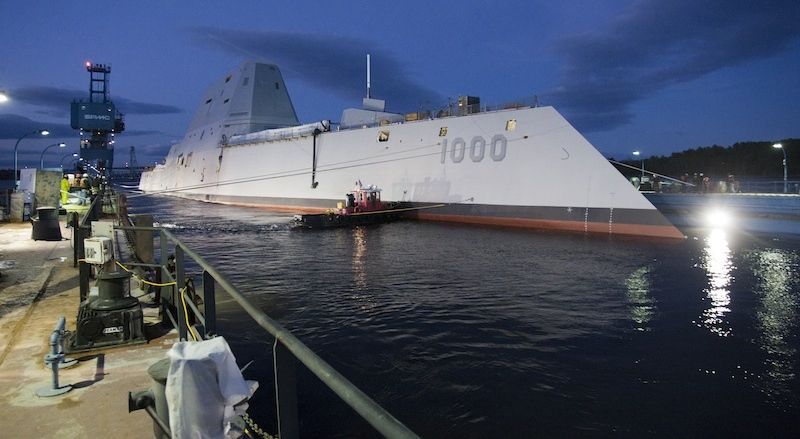
USS Zumwalt (DDG-1000)
WASHINGTON: Under intense budget pressure, a Pentagon cost-cutting team is pushing the Navy to cancel its third and last Zumwalt-class destroyer, the Lyndon Johnson (DDG-1002). But two sources familiar with the program say this cost-cutting measure just doesn’t add up.
The DDG-1000 Zumwalts are expensive; three ships will cost almost $13 billion. About $9 billion of that was spent on research and development alone. As a result, they’re the most sophisticated surface combatants in the Navy, with a radar-baffling hull and enough electrical power to run high-tech weapons like lasers and rail guns. To pack in all that technology, they’re also 60 percent larger than the standard Arleigh Burke (DDG-51) design. Originally intended as the follow-on to the Burkes, they grew so expensive that, in a classic death spiral, the Navy cut the production run repeatedly: from 32 to 24 to 16 to seven to three.
Now, according to a Pentagon memo, first reported by Bloomberg’s Tony Capaccio, the Defense Department’s independent Cost Assessment & Program Evaluation office (CAPE) is considering cutting the third ship — which is in large part already built and paid for.
“If they wanted to kill the third ship , they’re about two years late,” said Loren Thompson, a defense industry analyst and consultant — and member of BD’s Board of Contributors — who’s criticized the Navy’s handling of the Zumwalt program. “You will lose an entire warship, but you will only reclaim a fraction of the cost. So, given the likely political fallout, why would you do it?”
Counting the current fiscal year (which ends nine days from now), Congress will have appropriated $11.8 billion for the DDG-1000 program, out of a projected total of $12.8 billion. So the maximum possible amount left to save is $979 million, less than 8 percent of the total. (It might be more if the Pentagon somehow recouped funds spent in prior years, which is theoretically possible but awfully unlikely).
But that figure assumes you somehow manage to cancel the program immediately as of October 1st and you don’t spend another penny. That is legally and administratively impossible. The more likely scenario is that the requested figure for 2016 is appropriated too — there’s strong support for that in Congress — and the cut only takes effect with the fiscal 2017 budget, which is the one the Pentagon is currently working on. That means another $520 million gets spent and potential savings drop to a maximum of $458 million. And you can’t save all of that, either.
First, some of that half-billion is to complete the first two ships. They are not being canceled. Second, you would need to pay program shutdown costs and contract termination penalties. Considering how prolonged and expensive cancelling a program can be, with the infamous A-12 case taking 23 years, there may be no net savings at all. It’s possible the cancellation would end up costing the taxpayers more.
In brief, you’re forgoing a $3.5 billion ship — as third in the class, Johnson costs less than the first two — to save at most $1 billion and more likely less than half a billion (possibly zero). The marginal cost of just finishing the damn thing already is not high, in Pentagon terms.
There are of course years of operations and maintenance costs to consider, which would be higher for a Zumwalt than for a smaller, less complex destroyer like an Arleigh Burke. But the money saved by cancelling the last Zumwalt isn’t enough to buy you that smaller, less complex destroyer in its place, so you end up short a ship.
That is extremely unlikely to go over well with a Congress increasingly concerned about the Pacific and China. The Maine delegation has led the charge so far, since the Zumwalts are being built in their homestate’s Bath Iron Works (a General Dynamics subsidiary). But walking away from a mostly bought-and-built destroyer would also infuriate powerful chairmen like Senate Armed Services Committee’s John McCain, a retired Navy officer himself, and the House seapower subcommittee’s Randy Forbes.
“It’s unlikely that the third Zumwalt will be canceled because the amount of money saved isn’t commensurate with the political capital expended,” Thompson told me.
That said, the Navy had better find money somewhere, soon, and in quantities much larger than any fiddling with the Zumwalt class will get it.
“I would view Zumwalt as just the bow of a much bigger crunch in shipbuilding,” Thompson said. “The Navy is coming to a crisis in its shipbuilding account.”
At $15 billion a year, a small fraction of the Pentagon’s $500-plus billion budget, “there’s no way it can fit its modernization requirements,” Thompson said. The near-term problem is the Budget Control Act caps, but in the long term it’s the Ohio Replacement Program to build a new nuclear-missile submarine.
“Realistically, the Navy needs $20 billion a year for shipbuilding by the end of this decade,” Thompson said. Is that politically possible? “I think in the end, the Navy will get the money it needs, but nobody understands how to get from here to there.”
Updated 4:40 pm to clarify some fiscal details.
Multi-ship amphib buy could net $900M in savings, say Navy, Marine Corps officials
Lawmakers gave the Navy authorities to ink a multi-ship amphib deal years ago, but the service has not utilized that power yet.


























